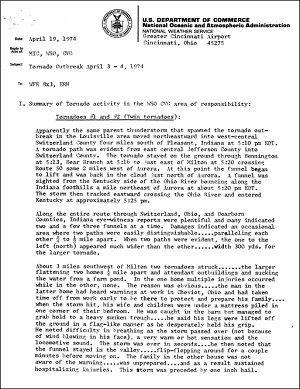
Aerial Damage Photos | Ground Damage Photos | Xenia F5 Track Map The April 3-4, 1974 Super Outbreak affected 13 states across the eastern United States, from the Great Lakes region all the way to the Deep South. In all, 148 tornadoes were documented from this event, of which 95 were rated F2 or stronger on the Fujita scale and 30 were F4 or F5. Aside from all the castastrophic damage they left behind, the tornadoes resulted in 335 deaths and more than 6000 injuries. |
The F5 Sayler Park tornado made it’s way along South Road in Green Township, sausing massive destruction and ultimately lifting in Dent near present day Lowes.
Tornado number 43, the Sayler Park F5, is the only tornado I ever personally witnessed. I was in third grade. More information here>>>
WSO Cincinnati’s area (inc. Sayler Park)









 >>>
>>>











